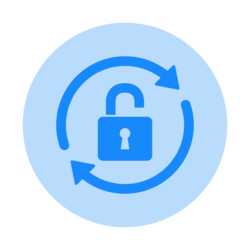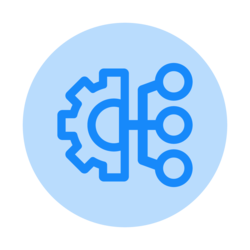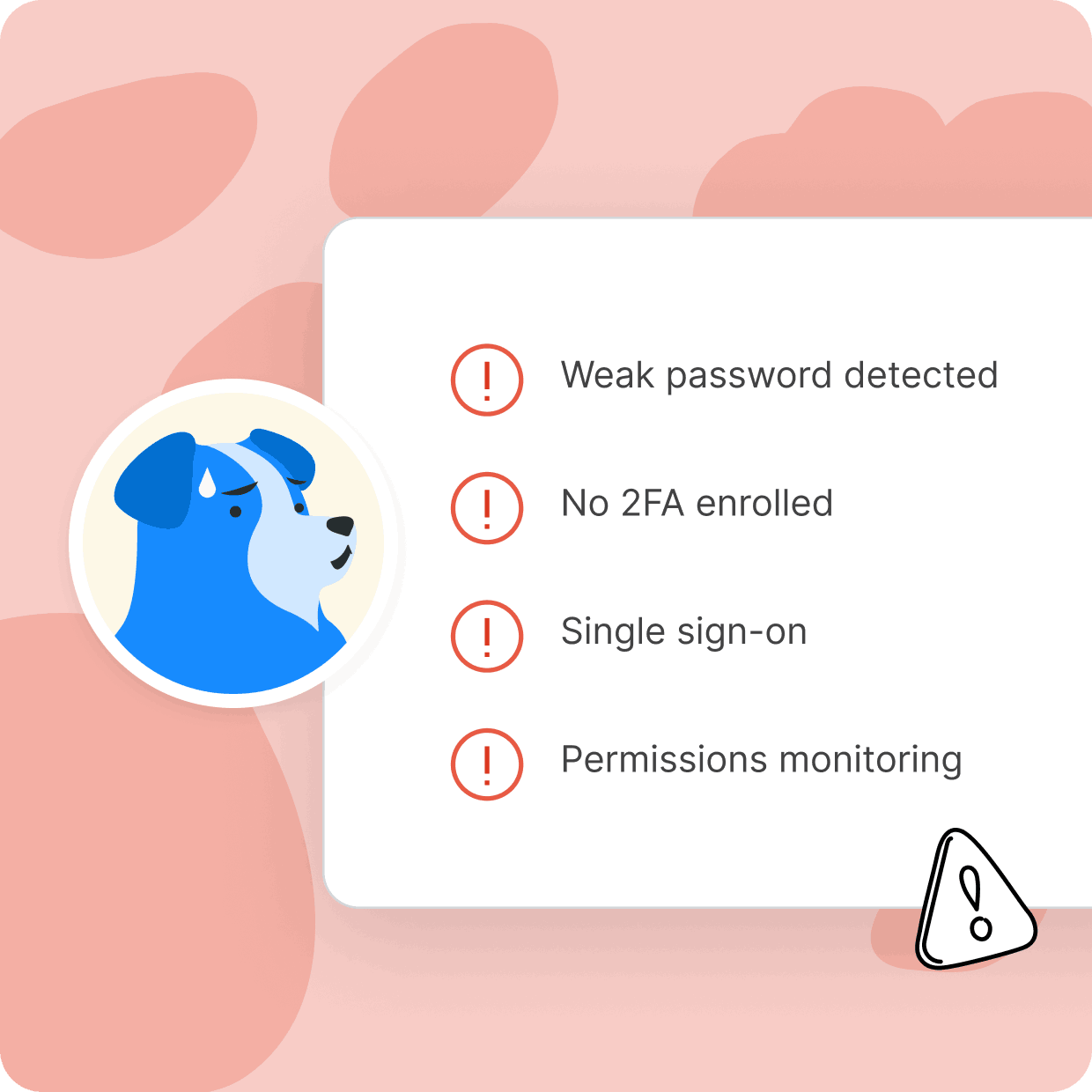Privilege access management (PAM) is a broad category of security tools that help manage access to sensitive accounts. Unfortunately, many applications don't support identity standards like the Security Assertion Markup Language (SAML) and the System for Cross-domain Identity Management (SCIM) specification. Without native support for these standards, applications either can't work with many PAM solutions or require expensive integrations.
Cerby allows you to manage all your SaaS administrator accounts, rotate credentials, and monitor and audit privileged account activities.
Secure Privileged Accounts
Not all accounts are created equal. Some come with administrative permissions that put sensitive data at risk when in the wrong hands. With Cerby, you can help protect your business from bad actors, mistakes, and data breaches.
With Cerby You Can

Secure your SaaS admin accounts

Protect your business from data breaches

Eliminate the costs of custom integrations
Privileged Access Management Solutions
Privileged Access Management (PAM) refers to solutions and protocols designed to manage and monitor the activities of privileged users within an organization. Privileged users are people or accounts with elevated permissions on a network or system, enabling them to access and manipulate sensitive data that regular users cannot. PAM security solutions provide access controls, credentials, and session management tools to minimize the risk of cyber-attacks and data breaches.
PAM security is becoming increasingly essential due to the growing sophistication and frequency of cyber-attacks. According to the 2021 Verizon Data Breach Investigations Report, 61% of cyber-attacks in 2020 involved stolen or compromised credentials, demonstrating the need for a more robust security solution to protect against these types of attacks. This is also emphasized in the Ponemon Institute research study, that 52% of their 500+ respondents say their organization has experienced a cybersecurity incident caused by the inability to secure nonfederated applications. Through the implementation of PAM, organizations can minimize the risk of cyber-attacks and prevent unauthorized access to their critical systems.
The key features of PAM security solutions include privileged user identity access management, password vaulting, session recording, and secure remote access management.
- Privileged user identity access management ensures that only authorized users access specific resources.
- Password vaulting provides secure storage for privileged credentials and allows for real-time password rotation to prevent unauthorized access.
- Session recording allows for detailed monitoring of privileged sessions to detect any suspicious activities or potential security breaches.
- Secure remote access management enables privileged users to securely and remotely access critical systems without risking data loss or unauthorized access.
By implementing PAM security solutions, organizations can maintain control over their critical systems and prevent unauthorized access that could lead to data breaches or cyber-attacks. As the security landscape evolves and the risk of cyber-attacks continues to grow, PAM security solutions become an increasingly integral part of any organization's security strategy.
Privileged Access Management Tools
Numerous privileged access management vendors offer tools and solutions designed to help organizations manage the security of their privileged accounts. For example, CyberArk is one of the leading PAM vendors. The CyberArk Privileged Account Security Solution includes features like a password vault, session recording, and threat analytics, making it one of the most popular and well-known PAM tools on the market.
- Arcon PAM is another notable vendor that provides a comprehensive privileged access management solution with features like threat intelligence integration, multi-factor authentication, and access request workflows.
- Azure Privileged Access Management is Microsoft's solution that provides role-based access control for Azure resources. This solution relies heavily on Azure Active Directory (Azure AD) and is ideal for organizations that operate exclusively in Microsoft's cloud.
- BeyondTrust PAM is another vendor that offers PAM solutions that comprise privileged account and session management, multi-factor authentication, and automated workflows.
- Okta PAM is a newer entrant in the market that combines flexible access controls with enhanced security, making it an ideal solution for organizations looking for a cost-effective alternative.
Other notable PAM solution vendors include Delinea, One Identity, and ManageEngine. Different vendors offer unique features and price points, and the right PAM solution for your organization will depend on your specific needs and requirements. Proper research and evaluation of privileged access management tools and vendors can ensure that your organization is deploying the right solution to manage its privileged access and safeguard its sensitive data and systems.
PAM vs. IAM
Privileged access management and identity and access management (IAM) are two types of software security that serve different — but related — purposes for enterprise organizations.
- PAM primarily focuses on managing and protecting privileged accounts with high levels of access to specific critical systems and data.
- IAM, on the other hand, focuses on managing general access for all user accounts across an organization.
The main difference between PAM vs. IAM is that while IAM manages normal user accounts throughout a whole organization, PAM manages specific groups of privileged access accounts, which have elevated permissions to access sensitive information or systems. PAM is often used in industries such as finance and healthcare, where strict regulations govern access to sensitive data, but it has value for any kind of organization that needs to protect any kind of sensitive data or critical systems.
While both PAM and IAM help organizations manage access to systems and data, each is suited for different use cases. PAM manages specific groups of privileged accounts with high-level access, while IAM is more concerned with managing account access broadly across an organization. Ultimately, the right software tools for your organization to implement will depend on your unique security requirements.
Privileged Access Management Best Practices
Implementing privileged access management solutions is crucial for organizations to ensure their sensitive data remains secure. The following privileged access management best practices should be considered when implementing PAM solutions:
- Organizations should adhere to privileged access management standards, such as ISO 27001.
- Organizations should develop a privileged access management policy template that outlines the policies and procedures to govern who has access to privileged accounts, how those accounts are accessed, what they have access to, and what activities are permitted. The policy should be reviewed and updated regularly to ensure it stays up-to-date, and it should align with the organization's overall security strategy.
- Organizations should ensure they adopt the principle of least privilege, which means granting only the minimum access required for users to perform their functions.
- PAM solutions should be deployed across all IT infrastructure, including cloud and on-premise systems, and must be able to automatically discover and manage all privileged accounts.
- PAM solutions should have real-time monitoring capabilities to detect and alert users about all privileged access activity.
- Education and training programs should be implemented to enhance PAM training and awareness. Users should be educated on the importance of responsible data handling and should be well-informed about security breaches and how to avoid them.
Privileged access management solutions are most effective when coupled with careful adherence to best practices such as compliance with privileged access management standards, effective PAM policy documentation, ongoing user education, and more.
Open-Source PAM Solution
Open-source privileged access management software is intended to help organizations secure their sensitive data by protecting privileged accounts. Open-source privileged access management tools have several advantages, such as lower costs and the ability to customize the software code.
Open-source PAM solutions are typically very cost-effective because there are no license fees to pay, which makes them great options for organizations with limited budgets. Additionally, open-source solutions offer a great deal of flexibility because users can modify the code to meet their specific needs. This enhances the value of the solution by providing support for unique use cases that may not be addressed by commercial tools.
Moreover, open-source PAM solutions regularly receive patches and upgrades from a passionate community of developers, helping to keep them up-to-date with the latest features and capabilities.
Open-source PAM solutions offer cost-effective and customizable options for privileged access management for organizations that want to improve their access management without breaking the bank or compromising flexibility.
Microsoft’s PAM tools
Microsoft environments offer many privileged access management tools to help organizations secure their sensitive data. One of the most popular tools is the Microsoft Identity Manager (MIM), which can be used to manage user identities and access controls. This tool enables IT administrators to define policies for granting or revoking access across the entire network, including cloud-based resources.
Microsoft PAM vs. Cyberark
One of the major players in the PAM space for Microsoft environments is CyberArk. While both Microsoft PAM and CyberArk privileged access management tools offer similar functionality, there are some key differences between them. Microsoft PAM is a native solution for Microsoft environments, while CyberArk's solution is cross-platform and can also integrate with non-Microsoft systems. CyberArk also has a greater focus on session management, providing a superior user experience.
Active Directory privileged accounts best practices
Following best practices for securing Active Directory privileged accounts is an important part of effectively leveraging privileged access management tools in Microsoft environments. Best practices include minimizing the number of privileged accounts, regularly reviewing privileged access, and using multi-factor authentication to protect against unauthorized access. Organizations can also leverage tools like Microsoft's Advanced Threat Analytics to monitor privileged access activity in real-time and flag any suspicious behavior.
Microsoft offers a range of privileged access management tools to secure sensitive data in its environments. By adopting best practices and leveraging advanced tools like Microsoft's Advanced Threat Analytics, businesses in Microsoft environments can effectively manage privileged access and minimize security risks.
Arcon Company PAM Implementation Best Practices
Implementing reliable PAM software solutions is one of the best ways to ensure privileged accounts remain secure. Tools like Arcon software for privileged access management can help organizations monitor privileged access and keep their systems secure against undesired access.
Privileged access management best practices dictate certain prerequisites to ensure a successful implementation. One prerequisite is to identify and follow widely-accepted privileged access management standards, including those established by the National Institute of Standards and Technology (NIST) and Gartner privileged access management best practices.
Another crucial prerequisite for successfully implementing PAM solutions such as Arcon is to develop a privileged access management policy PDF or privileged access management template that contains a PAM process document outlining rules for authorization and accountability. It's also best practice to monitor all privileged account activity for suspicious activity or breach attempts.
For example, Salesforce is a popular customer relationship management system that can benefit from best practices for privileged access management. One best practice for PAM in Salesforce is to ensure that access requests are approved by the appropriate departments, with the proper access levels granted based on an individual's job function. Organizations should also consider the activation or deactivation of roles based on changes in employment or job function.
By imposing tighter control over critical systems and sensitive data through privileged access management, organizations can strengthen their security posture, increase customer trust, reduce cyber liability, and achieve compliance with regulations and regulatory agencies.

